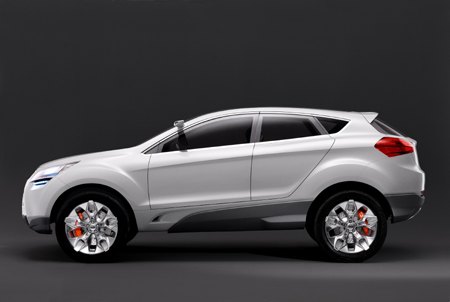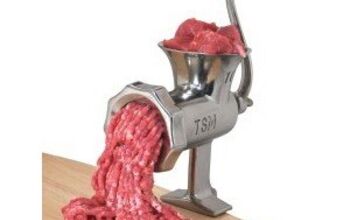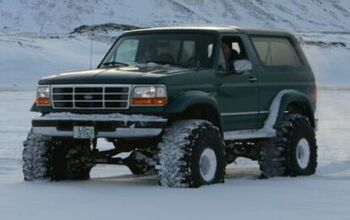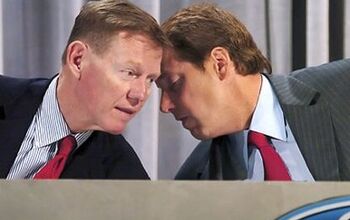Ford Death Watch 12: By the Numbers
First the good news. For the first time in eight long months, George Pipas, Ford's man in the crosshairs Manager of Sales Analysis, could deliver glad tidings to anxious stockholders and stakeholders. September retail and fleet results reveal that sales of Ford’s cars and truck were up when compared against the same month in '05. Although FoMoCo’s sales increases didn’t come anywhere near Toyota’s dramatic advance, the Detroit-based automaker bested cross-town rivals GM and Chrysler by a considerable margin. And the hits keep happening.
Ford’s Explorer explored territory it hasn’t seen since August of last year (up 22%), and the gargantuan Expedition enjoyed more attention too. Demand for the Hecho en Mexico Fusion fueled a sedan sized fiesta at the Blue Oval to the tune of a 5.3% gain. These increases were enough to nudge Dearborn’s market share to 16.5%, more than a half point better than last September. With the cross border crossover poised to make its debut, FoMoCo enters the final quarter on an upturn with old metal moving and new metal buzz.
Now the bad news: Mulally’s much maligned motor company isn’t out of the woods yet. A closer look at the numbers indicates that little has changed. Fleet sales still bolster 26% of the movement. And while 74% retail composition is nothing to sneeze at, the fact that those sales are heavily incentive laden, is. Cash on the hood and no interest loans for anyone with a pulse continue to be the way fordward. October is truck month and as Toby Keith sings the praises of the venerable F-150, White Trash With(out) Money can drive the country star’s favorite whip off dealer lots and still have cash left to go “Get Drunk and Be Somebody”.
Inventory currently sits at around 650k units, and the fall season means model year closeouts. To make room for next year’s lot litter, 0% financing is being offered on all non truck vehicles, save Mustang and Fusion. While this will no doubt relieve dealer lots, it does little to help Ford, and will only cripple the profitable Ford Motor Credit unit. To have any chance of survival FoMoCo must deliver on its promise of profitability by the end of the decade. To do that, a “product lead turnaround” is going to need a healthy dose of cash flow. No matter how much metal is moved, virtual loss leaders are not the answer.
A study conducted by Harbour-Felax Group found that incentives and fleet sale discounts cost motor city manufactures an average of 11% in much needed profit. Japanese competition was able to generate an average of $24,289 per car, while homegrown products only put $21,597 back into the pot. Diluted profits translate directly into lost product development. In order to engineer and design market grabbing people movers, Dearborn must turn its knife to sticker play and maintain price points.
That’s not all though. Not only does Ford make less on each vehicle they produce, they also spend more doing so. It’s no secret that FoMoCo faces incredible cost resistance to profitable production. Health care woes and the union straightjacket ensure that every lost work day results in a $70 per vehicle cost increase. Tack on another $70 each for the extra 16 minutes of break time that every blue collar gets during a shift. Assuming the best case/least likely scenario of perfect attendance by unionized workers, and steady annual sales of 3.1m vehicles, last year’s work breaks alone cost FoMoCo $217m. The money was literally pissed away.
Compared to Toyota, The Blue Oval coughs up an average of $2,165 more per vehicle produced. Health care advantages, decreased warranty costs, cheaper labour and better use of flex manufacturing ensure that the megalomaniacal Japanese automaker has an immense $6.7b annual cost advantage over its competition in Dearborn. Note: Ford’s production capacity won’t reach 100% until 2008. Add to that the aforementioned 11% revenue lost from fleet sales and incentives and it becomes clear how difficult a job Alan Mulally has ahead of him.
Unfortunately, The Way Fordward 3.0 will fail. The cuts were too little too late. Despite the attempt to balance a projected 14% market share with right sizing production cuts, most analysts agree that Ford has a 0% chance of achieving profitability on three million annual units. Going Fordward, a product-led turnaround will require enormous amounts of cold hard cash. Given the current state of affairs and the fact that buyout packages will drain the corporate coffers throughout the first three quarters of next year, rising costs will eat the development cash, and take much of Ford’s hope with it.
In short, year-on-year post-Katrina and fire sale comparison aside, the mistakes of the past will continue to haunt FoMoCo for years to come. The truth is in the numbers, and as we know, numbers don’t lie.
More by Neunelf
Latest Car Reviews
Read moreLatest Product Reviews
Read moreRecent Comments
- Lou_BC Well, I'd be impressed if this was in a ZR2. LOL
- Lou_BC This is my shocked face 😲 Hope formatting doesn't fook this up LOL
- Lou_BC Junior? Would that be a Beta Romeo?
- Lou_BC Gotta fix that formatting problem. What a pile of bullsh!t. Are longer posts costing TTAC money? FOOK
- Lou_BC 1.Honda: 6,334,825 vehicles potentially affected2.Ford: 6,152,6143.Kia America: 3,110,4474.Chrysler: 2,732,3985.General Motors: 2,021,0336.Nissan North America: 1,804,4437.Mercedes-Benz USA: 478,1738.Volkswagen Group of America: 453,7639.BMW of North America: 340,24910.Daimler Trucks North America: 261,959


































Comments
Join the conversation
Sajeev, "How much work did it take to put new parts on the Crown Vic’s ladder frame, cost cut a Volvo S80 and put a Taurus motor in it, and Americanize the Mazda 6?" It takes 1 engineer, 1/8th a purchasing rep, 7 finance reps, 27 project managers, 10 engineering and program managers, 4 chief engineers, 4 directors, and 4 VPs.
I think what Ford may need to do is something really radical, such as build a car like the GM EV1 (electric car) or a high performance car with an internal combustion engine radical as the old SOHC V8 was, back in the 1960s. The Futura station wagon is definitely something they should make a "go" of. They need to quit making so many Explorers and Mountaineers; and perhaps drop the Expedition, entirely. If any dealers complain - likely they would, given the profit margin on SUVs - they need to be reminded that they are car dealers first, truck dealers second - or even third.